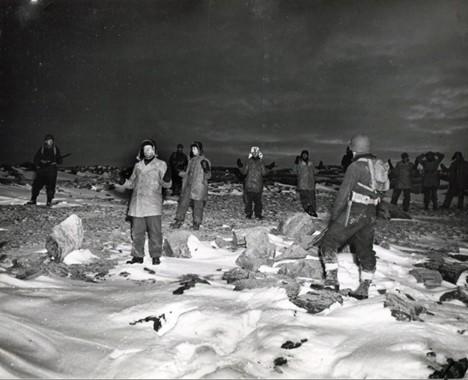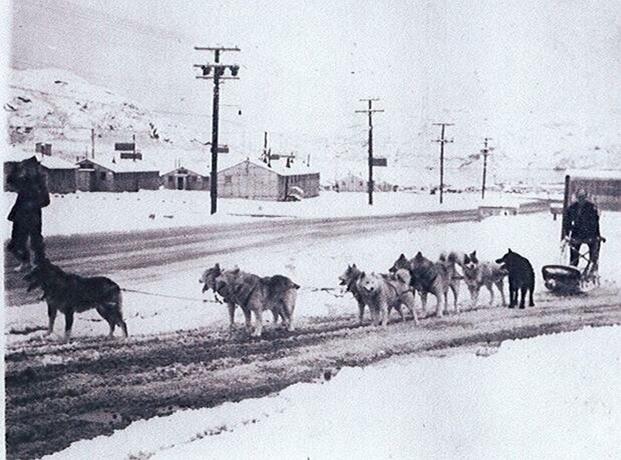When Nazi Germany overran Denmark in April 1940, the Danish colony of Greenland was suddenly cut off from its government. Under an April 9, 1941, defense agreement, the United States assumed responsibility for Greenland’s security. The pact led to one of America’s earliest overseas deployments of World War II—months before Pearl Harbor—as U.S. forces built bases, guarded resource mines, and waged a covert campaign against German weather stations along Greenland’s coast.
Denmark Turns to America
With Denmark under German occupation, the country’s ambassador in Washington, Henrik Kauffmann, refused to take orders from a government controlled by Berlin. Acting on his own, he approached the Roosevelt administration and signed the “Agreement Relating to the Defense of Greenland” on April 9, 1941. The pact allowed the United States to station troops, build bases, and operate freely across the island for the duration of the occupation.
Kauffmann later explained his defiance in a letter preserved by the U.S. State Department, writing, “Under the circumstances, there was, to me, no doubt but that I must, in the interests of Denmark and Greenland, take this unusual step… according to my best belief and the dictates of my conscience.” His decision gave Washington legal cover to occupy Greenland even before America formally entered the war. This prevented German troops from quickly occupying the island after Denmark’s collapse.
Within months, Army engineers and Coast Guardsmen began arriving along the west coast, surveying sites for airfields and communications posts. The largest, Bluie West One at Narsarsuaq, became a critical refueling stop for aircraft that later crossed from the United States to Britain and North Africa. Before long-range bombers and transports could span the ocean in a single flight, Greenland’s icy airstrips provided a vital layover for thousands of planes headed to combat.

An Island at War
Greenland’s strategic importance wasn’t just its geography. Beneath its ice sheets was one of the Allies’ most valuable resources: cryolite, a mineral mined near Ivigtut that was essential to aluminum production. Without cryolite, large-scale aircraft manufacturing would have been impossible. Protecting the mine became an early American priority, and Coast Guard cutters soon patrolled its approaches to keep German submarines and raiders away.
The Germans were quick to see Greenland’s importance in another realm. Arctic weather systems moved eastward across the Atlantic, influencing everything from convoy schedules to bombing raids over Europe. Germany’s military meteorologists hoped to install hidden outposts along Greenland’s remote eastern coast to transmit forecasts back to the Reich. If successful, those stations could give U-boats and the Luftwaffe a valuable edge in combat.
To counter them, the U.S. established the Greenland Patrol, a Coast Guard command under Capt. Edward “Iceberg” Smith. Its mission was to defend the coastline, escort supply ships, and hunt for enemy weather parties. The patrol’s ships operated in near-polar darkness, breaking ice with reinforced hulls and explosives while battling conditions that were some of the harshest on Earth.

The Battle for Greenland
The first action of the Greenland campaign came months before Pearl Harbor. On Sept. 12, 1941, the USCG cutter Northland seized the Norwegian sealer Buskø, a ship suspected of supporting a German radio team. The Americans captured the crew and destroyed the transmitter, marking one of the earliest U.S. naval actions of the war.
In 1943, actual combat reached the arctic. Members of the Danish-led Northeast Greenland Sledge Patrol, made up of Danes, Norwegians, and Greenlanders with their dog-sleds, discovered boot prints leading to a German installation on Sabine Island. “Footprints—human footprints—boots, with heels!” one patrolman shouted when they found the trail. None of the team wore actual boots with heels on them, alerting them to enemy spies in the area. The team found a cabin stocked with supplies and Nazi uniforms.
Soon after, German troops attacked their base at Eskimonæs, killing Danish Corporal Eli Knudsen and forcing the survivors into a desperate retreat across the snow. In the chaos, they had to leave behind their dogs and most of their supplies, forcing them to suffer a 400-mile trek through the harsh terrain. Lieutenant Hermann Ritter, the officer in charge of the German forces, was later captured and turned over to American authorities after an exhausting sled journey through subzero storms.
Using reports from the Sledge Patrols, American planes bombed the German base on Greenland, codenamed Holzauge. U.S. Coast Guard cutters later landed to destroy the German camp. They found it abandoned, though they captured one German who was left behind to man the station. Danish troops later raided another German weather station, destroying it and leaving a German officer dead.
In October 1944, USCGS Eastwind seized the German weather station on Little Koldewey and took twelve German prisoners. Eleven days later, she boarded and captured the trawler Externsteine, taking seventeen more prisoners and ending Germany’s weather operations on the coast. These were the only direct engagements between American and German troops on Greenland.

Legacy
When Germany surrendered in 1945, the United States had built 17 installations across Greenland, from weather stations and supply depots to full airfields. Although the skirmishes were brief and minor, several casualties occurred on both sides, in addition to the horrid conditions troops faced on the island.
After the war, Denmark regained control over the island, but several U.S. bases remained active through the Cold War, such as Thule Air Base, still one of America’s northernmost military bases. The island’s wartime experiences also set the stage for later debates over the its value.
In 2019, President Donald Trump highlighted the island’s strategic importance when he expressed his interest in buying the island. He told reporters, “Essentially, it’s a large real estate deal.”
Danish Prime Minister Mette Frederiksen dismissed the idea and outright rejected Trump’s proposals. Denmark pledged $8.5-million in investments on the island to deter the U.S. Greenland’s Prime Minister, Múte Bourup Egede, noted the island’s future “will be decided by Greenland.”
Greenland’s wartime experience rarely makes it into history stories of World War II. Nevertheless, the American campaign in Greenland prevented weather intelligence for the Germans, secured resources for the Allied war effort, and gave the Allies a vital supply hub for offensives in Europe.














